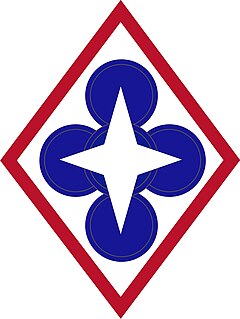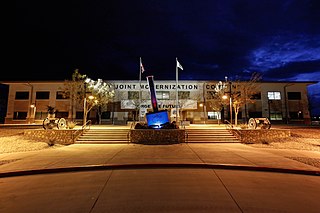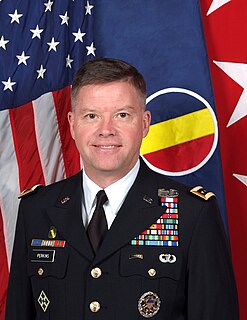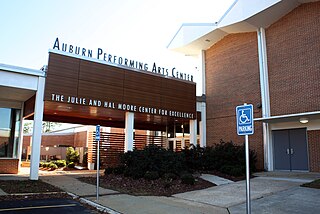Fort Eustis is a United States Army installation in Newport News, Virginia. In 2010, it was combined with nearby Langley Air Force Base to form Joint Base Langley–Eustis.

Established 1 July 1973, the United States Army Training and Doctrine Command (TRADOC) is a major command of the United States Army headquartered at Fort Eustis, Virginia. It is charged with overseeing training of Army forces and the development of operational doctrine. TRADOC operates 37 schools and centers at 27 different locations. TRADOC schools conduct 1,304 courses and 108 language courses. The 1,304 courses include 516,000 seats for 443,231 soldiers; 36,145 other-service personnel; 8,314 international soldiers; and 28,310 civilians.

The U.S. Army Combined Arms Support Command (CASCOM), a major subordinate command of the Training and Doctrine Command (TRADOC), is located at Fort Lee, Virginia. Underneath CASCOM Headquarters is the Sustainment Center of Excellence (SCoE).

The U.S. Army Combat Capabilities Development Command Aviation & Missile Center (AvMC), formerly known as the U.S. Army Aviation and Missile Research, Development and Engineering Center (AMRDEC), a part of the U.S. Army Research, Development, and Engineering Command (RDECOM) — now CCDC, is primarily a civilian organization tasked to provide research, development and engineering technology and services to support U.S. Army aviation and missile platforms. AvMC conducts research, promotes development, engineering and simulation laboratories and facilities used to develop and improve aviation and missile components, subsystems and systems.

The reorganization plan of the United States Army is a current modernization and reorganization plan of the United States Army that was implemented under the direction of Brigade Modernization Command. This effort formally began in 2006 when General Peter Schoomaker, was given the support to move the Army from its Cold War divisional orientation to a full-spectrum capability with fully manned, equipped and trained brigades; this effort was completed by the end of 2016. It has been the most comprehensive reorganization since World War II and included modular combat brigades, support brigades, and command headquarters, as well as rebalancing the active and reserve components. The plan was first proposed by the Army's 34th Chief of Staff, Eric Shinseki, in 1999, but was bitterly opposed internally by the Army. By 2020, the Army's 40th Chief of Staff was calling for transformational change, rather than incremental change by the Army.

The U.S. Army Combined Arms Center (USACAC) is located at Fort Leavenworth and provides leadership and supervision for leader development and professional military and civilian education; institutional and collective training; functional training; training support; battle command; doctrine; lessons learned and specified areas the Commanding General, United States Army Training and Doctrine Command (TRADOC) designates in order to serve as a catalyst for change and to support developing relevant and ready expeditionary land formations with campaign qualities in support of the joint force commander.

The Asymmetric Warfare Group is a United States Army unit created during the War on Terrorism to mitigate various threats with regard to asymmetric warfare. The unit is headquartered at Fort Meade, Maryland and has a training facility at Fort A.P. Hill, Virginia. The unit provides the linkage between Training and Doctrine Command (TRADOC) and the operational Army, and reports directly to the commanding general of TRADOC. It is composed of senior active duty Soldiers, Department of the Army (DA) civilians, and contractors who are seasoned war fighters and functional area experts that are prepared to deploy globally.

The Combat Capabilities Development Command, (DEVCOM) is a subordinate command of the U.S. Army Futures Command. RDECOM was tasked with "creating, integrating, and delivering technology-enabled solutions" to the U.S. Army. Headquartered at Aberdeen Proving Ground in Maryland, RDECOM employed more than 13,000 scientists, engineers, researchers, and support personnel working at six major RDE centers and at the U.S. Army Research Laboratory, providing nearly all of the Army's basic and applied research and development services, including in collaboration with other branches of the armed forces and through a network of more than a thousand academic, industrial, and international partners.

Maxie L. McFarland, was one of thirteen tier-3 US Government Defense Senior Executives, serving as the Deputy Chief of Staff for Intelligence (G–2) for the U.S. Army's Training and Doctrine Command located at Fort Monroe, Virginia. Starting in June 2011, he worked as the Executive Vice President for Strategic Planning for the Sierra Nevada Corporation. Maxie McFarland died on 8 November 2013 and is buried at Arlington Cemetery. He was inducted into the Military Intelligence Hall of Fame in 2014.

To reinforce the Army profession and its Ethic, the Army Chief of Staff (CSA) established the Army Center of Excellence for the Professional Military Ethic (ACPME) in May 2008. Located at West Point, New York, the wellspring of professional soldier values for more than 200 years, the ACPME was re-designated as the Center for the Army Profession and Ethic (CAPE) and realigned to fall under the command and control of the United States Army Training and Doctrine Command (TRADOC) and its Combined Arms Center (CAC) in August 2010. CAPE's objectives were to assess the state of Army as a profession and its members as professionals; to study and define through doctrine and strategic messaging the Army Profession; capture and promulgate the moral principles of the Army Ethic, Army culture, and organizational climates; inspire trusted Army professionals to live up to their sacred oaths, increase Army members’ understanding and internalization of what it means for Soldiers and Army Civilians to be members of an honored profession; accelerate professional and character development in individuals, units, and Army culture through training, education, and leader development. AR 600-100 Army Profession and Leadership specified 12 tasks for CAPE to serve the Army in leader development, critical thinking and ethical decision making based upon the moral principles of the Army Ethic. Army Doctrine Publication (ADP) 1 and Army Doctrine Reference Publication (ADRP) 1. CAPE, as the AR 5-22 Army Force Modernization Proponent for the Army Profession, Character Development, and the Army Ethic was the US Army and lead responsible for Doctrine, Organization, Training, Materiel, Leadership and Education, Personnel and Facilities (DOTMLPF) initiatives to reinforce the Army Profession of Arms, Army Ethic, and culture. In September 2019, CAPE was merged with the Center for Army Leadership at Fort Leavenworth, KS to form the Center for the Army Profession and Leadership. About CAPE,</ref>

The U.S. Army Joint Modernization Command, or JMC, based in Fort Bliss, Texas, gains insights from "Fight Tonight" units about future ways of fighting, future technology, and force structure during realistic live, constructive, and/or simulated training exercises. Joint Modernization Command is subordinate to the Army Futures & Concepts Center in Joint Base Langley-Eustis, Virginia; both report to the U.S. Army's newest Four-Star Command, the Army Futures Command (AFC) based in Austin, Texas.

David Gerard Perkins is a retired United States Army four-star general. His last assignment before retiring was commander of the United States Army Training and Doctrine Command.

A center of excellence (COE) is a team, a shared facility or an entity that provides leadership, best practices, research, support and/or training for a focus area.

Larry Wyche, is a retired United States Army Lieutenant General. He last served as the deputy commanding general of the U.S. Army Materiel Command. Prior to his last assignment, Wyche served as the Special Assistant to the Commanding General, U.S. Army Training and Doctrine Command. He has also served as commanding general of the Combined Arms Support Command, commanding general of the Sustainment Center of Excellence (SCoE) and Senior Mission Commander for Fort Lee, Virginia.
"We are Warfighter Logisticians and Supporters, prepared to give the shirts off our backs and boots off our feet, to support the fight. We will never say no, as long as there is one gallon of gas to give, or one bullet to give"

The Human Dimension is a framework for United States Army to Optimize Human Performance as part of Force 2025 and Beyond. The Human Dimension White Paper expands on the topic covered in this page.

United States Army Futures Command (AFC) is a United States Army command aimed at modernizing the Army. It currently focuses on six priorities: 1— long-range precision fires, 2— next-generation combat vehicle, 3— future vertical lift platforms, 4— a mobile & expeditionary Army network, 5— air & missile defense capabilities, and 6— soldier lethality. AFC's cross-functional teams (CFTs) are Futures Command's vehicle for sustainable reform of the acquisition process for the future.

John Michael “Mike” Murray is a United States Army general, the first commanding general of United States Army Futures Command (AFC), a new four-star Army Command (ACOM) headquartered in Austin, Texas. Murray was previously the G-8, a deputy chief of staff to the Chief of Staff of the United States Army (CSA). G-8s serve as principal advisor to the CSA for materiel requirements, as military counterpart to the Assistant Secretary of the Army for acquisition, logistics, and technology. Modernization reform is the focus of AFC, which means readiness for a nearer-term future, whereas immediate readiness is the charter for the current ACOMs: FORSCOM, TRADOC and AMC, as well as the army service component commands, such as USARPAC. Previous modernization efforts involved five and ten year plans, but a goal for AFC is to reduce the requirements definition stage from five years to one year.

The United States Army Acquisition Corps (AAC) is the officer corps of the United States Army Acquisition Workforce (AAW). The Acquisition Corps is composed of army officers who serve in acquisition, a specialized form of product development, fielding, and support. These officers begin their careers in the other branches of the army for eight years, after which they may elect the Acquisition branch as their career as assistant program managers (APMs), program managers (PMs), and program executive officers (PEOs). Four percent of the 40,000 members of the army acquisition workforce are army officers; the remainder are largely civilians, with some contingency contracting NCOs for urgent or emergency contracts.

Cedric T. Wins is a retired U.S. Army general officer. Major General Wins was the last commander of RDECOM, in the U.S. Army Materiel Command, and the first commanding general (CG) of Combat capabilities development command (CCDC), in the Combat development element of U.S. Army Futures Command. In all, some 13,000 people work in some Science and Technology (S&T), or capacity for CCDC.

Eric J. Wesley is the Executive Vice President of Flyer Defense, a manufacturer of mission specialized, lightweight, off-road wheeled tactical vehicles capable of internal transport in rotary and tilt wing aircraft. Wesley is a former United States Army Lieutenant General who retired from the U.S. Army on September 1, 2020.




















